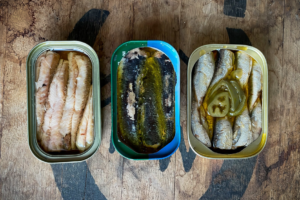It’s that time of year when the weather turns cooler and our thoughts turn to goblins, ghouls and all things Halloween. So, I thought it’d be timely to write about trick-or-treating and the candy that accompanies it. First, I want to clarify that this post isn’t going to tell you not to let your kids eat candy and treats. But with all things, it’s good to be aware of the effects of sugar and why you may want to limit how much sweets you give your little ghosts and goblins this season. Turns out, the treats that your children collect may be tricking their brains and bodies in not-so-good ways.
Before I go on, I want to tell you a story. Many years ago during the Halloween time frame, when my kids were little, I had a dish of fun-size candy bars on my kitchen island in addition to the apples and other fruits I normally had available for my kids to munch on when needing a snack. My neighbor came to my house and asked me how I could leave candy out and not have my kids devour it on the spot like her kids would. She told me she had to hide candy at her house and she never let her kids eat it (even though I knew she did). And, I witnessed her complaint in action when her children came to my house. They did exactly what she said – they kept taking candy until I took the dish away. I realized this was a case of the “beware of the forbidden food syndrome!” At that moment, I saw that the human condition of wanting what we can’t have was in full swing here. Was that all that was going on? Not sure, but it definitely was part of the problem. When we make something absolutely forbidden, it becomes that much more enticing and hard to resist. This is true for adults as well as children. Deny yourself something and that becomes all you want or think about. I’ve never had candy be completely off limits to my children, but I did monitor how much they ate and I offset that with healthy treats and snacks like apples, and other various fruits and vegetables. I also made sure that the majority of their food intake was otherwise healthy, nutritious and delicious. If they did have a piece or two of candy, it was a small part of their diet. And because it wasn’t completely off-limits, it didn’t provoke the “I want what I can’t have” mentality. If you start this at a young age, you lay the foundation for an overall healthy approach to eating. While I did not regularly have candy in the house, I did feel that having flexibility and participating in some traditions of the holidays were important.
Without really being aware of it at the time, I was also teaching my kids to make good choices when presented with not-so-good ones. This is a lesson that is applicable to many other facets of life. As parents, we want to teach our kids to make positive choices in their lives. Helping your kids do this at an early age empowers them and strengthens that “good choice” muscle. One way to help them your kids learn this during Halloween would be to let them pick out a few pieces of their favorite candy and let your kids enjoy their chosen candy, rationing the pieces out over the next several days, and removing further temptation by throwing the rest away. Agree together that they’ll get to have their treats and then it’s good to return to healthier food options.
Why should you do this? Besides the “forbidden food” issue mentioned above, you want to limit your children’s, and your own, intake of sugars because there are many negative effects of sugar consumption. Sugar stimulates appetite, so the more you eat it, the more you want to eat. That’s one trick of these treats. It can significantly increase a hormone called ghrelin, which promotes hunger and decrease peptide YY which is a hormone that makes you feel satisfied and reduces hunger. Studies have shown high intakes of sugar with risks of increased weight gain and obesity, heart disease, diabetes, skin problems such as acne and acceleration of the aging process in the skin, cancer, depression, anxiety, cellular degeneration, triglycerides, inflammation, fatty liver, kidney disease, tooth decay, and dementia. That’s a long list of ailments that you surely want to avoid for yourself, and especially help your children avoid!
The 2015-2020 Dietary Guidelines for Americans recommend that added sugars make up no more than 10% of your daily calories. If you are eating 2000 calories per day, that would mean you should not take in over 200 calories from added sugar. Here’s some perspective on that – 200 calories of sugar is the equivalent of 12 teaspoons of sugar! The American Heart Association is even stricter in their guidelines and recommends no added sugar for children under 2 years of age, no more than 100 calories for children over 2 and for women, and no more than 150 calories for men. That comes out to about 6 teaspoons (25 grams) for children over 2 and women, and 9 teaspoons (38 grams) for men. One 12-ounce can of regular soda has approximately 160 calories or about 10 teaspoons of added sugar. You can start paying attention to sugar intake by looking at the nutrition label and reading how many grams of sugar are in a serving (this is key also, because depending on the size of the candy bar, the entire bar could be more than one serving!). You’ll start to see how the sugars add up quickly. You might not realize how much sugar you and your children are consuming on a regular basis!
Awareness is the first step when it comes to changing a habit. The holiday season will be kicking off with Halloween fast approaching. Then comes Thanksgiving, Christmas and New Year’s. There will be lots of opportunities for your family to indulge in delicious sweets over these next couple of months. It’s important to teach your kids that it’s okay to indulge sometimes – after all, the holidays involve lots of social events that revolve around food. It’s unrealistic to think you can avoid or stop eating sugar altogether, but you can focus on eating healthy and nourishing foods along with a limited amount of sweet treats mingled in. You may not be able to eat as much of the sugared treats that you want, but there’s a better chance that if you limit sugars, you just might live longer and be able to enjoy ALL foods for a longer time! Do it for you and help your children do it for themselves, too.
Happy Halloween and turn the tables on those treats that trick!
Warmly,
Irene







